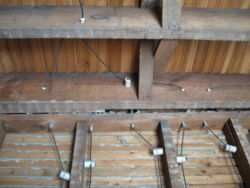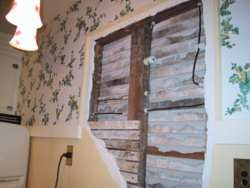Knob and Tube Wiring
Knob and tube wiring was the earliest standardized method of electrical wiring in buildings, in common use from about 1880 to the 1930s. It consisted of single insulated copper conductors run across interior walls or within ceiling cavities, passing through joist and stud drill-holes via protective porcelain insulating tubes, and supported along their length on nailed-down porcelain knob insulators. Where conductors entered a wiring device such as a lamp or switch, they were protected by flexible cloth insulating sleeving. The first insulation was asphalt saturated cotton cloth, then rubber became common. Wire splices in such installations were twisted for good mechanical strength, then soldered and wrapped with friction tape (asphalt saturated cloth), or made inside metal junction boxes.
The ceramic knobs were cylindrical and generally nailed directly into the wall studs or floor joists. Most had a circular groove running around their circumference, although some were constructed in two pieces with “pass-through” grooves on each side of the nail in the middle.
By wrapping electrical wire around the knob and then twisting the wire, the knob securely and permanently anchored the wire. The knobs separated the wire from potentially combustible framework, facilitate changes in direction, and ensure that wires are not subject to excessive tension. The wires were also in air, thus could dissipate heat well.
Ceramic tubes were inserted into holes bored in wall studs or floor joists, with wires running through them. This kept the wires from rubbing against the wood, or being compressed by the wood as the house settled.
Other ceramic pieces would typically be used as a junction point between the wiring system proper and the more flexible cloth-clad wiring found in light fixtures or other permanent, hard- wired devices. When a generic power outlet was desired, the wiring could run directly into the junction box through an insulating sleeve called loom.

Example of Knob and Tube Wiring from a 1930’s house.
Disadvantages
Historically, wiring installation standards were less stringent in the age of knob-and-tube wiring than today. Compared to modern electrical wiring standards, the main shortcomings of knob-
and-tube wiring are: knob-and-tube wiring never included a safety Grounding conductor; did not confine switching to the hot conductor (the so-called Carter System places loads across the common terminals of a three-way switch pair); it permitted the use of in-line-splices in walls without a junction box. Compared to modern thermoplastic wiring insulation, the K&T wiring was less resistant to damage, and had a higher temperature rating.

Knob and tube wiring at a museum display
Older homes may have knob-and-tube wiring for all or part of their electrical system. Such wiring may require replacement and modernization, as they are generally inadequate for modern levels of power use. As power use increased following the Second World War, first-generation wiring systems became susceptible to abuse by frustrated homeowners who would avoid repeatedly blowing fuses by overfusing the circuits, thus subjecting the wiring to damage due to higher levels of current. Or overfusing because K&T was rated for use in air, so 14AWG copper could handle 20 amperes, whereas in cable it is rated 15 amperes.
Knob-and-tube wiring may also have been damaged by building renovations. Its rubber insulation will be dried-out, thus brittle when handled, or it may have been damaged by rodents or carelessness (for example, hanging objects off wiring running in accessible areas like basements). Currently the United States NEC forbids use of insulation over knob-and-tube wiring, so energy efficiency upgrades to home insulation also requires replacement of the wiring in affected homes.
Learn more about What is UL listing? here >>
